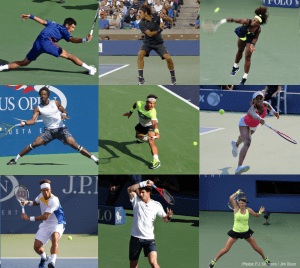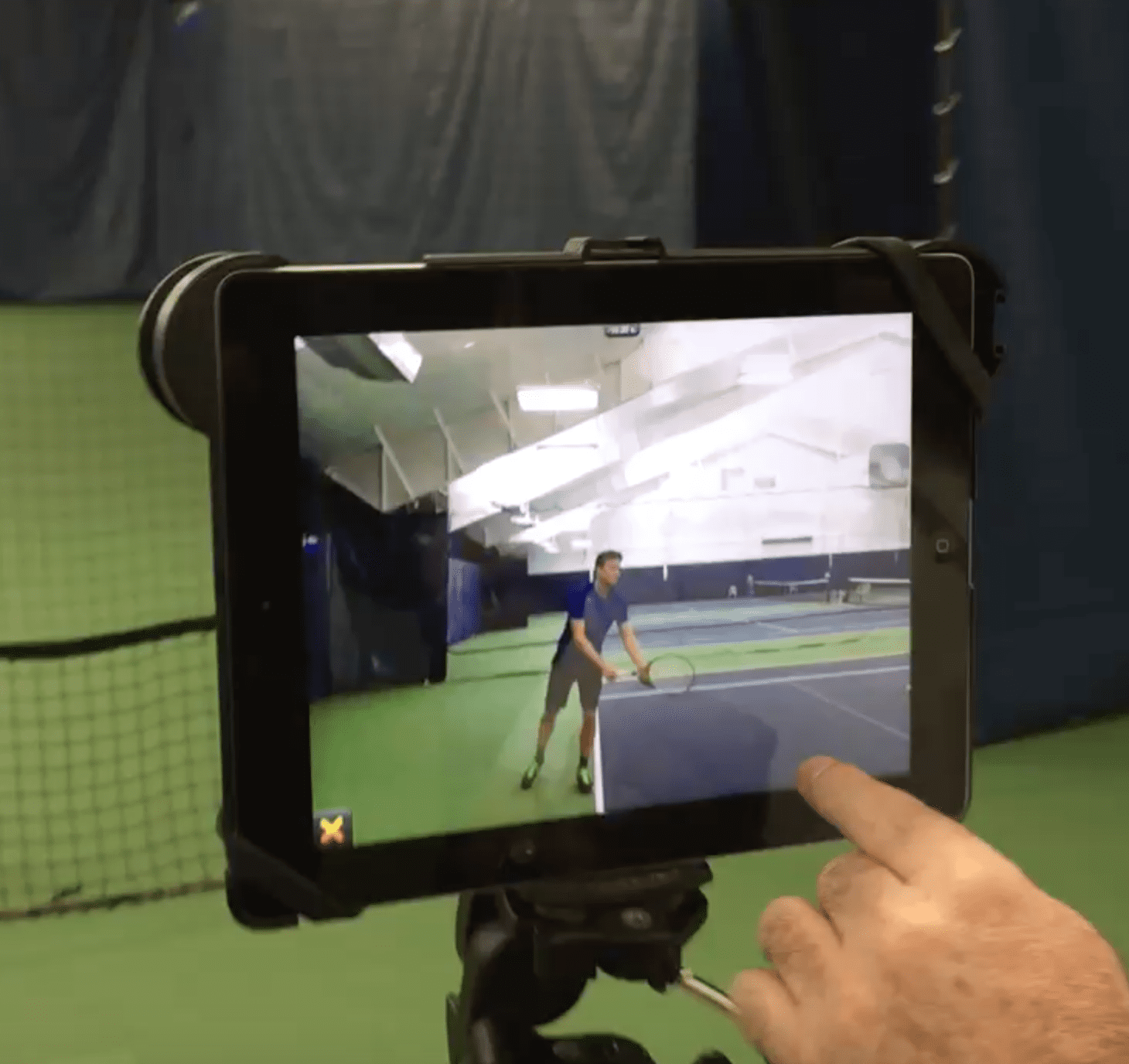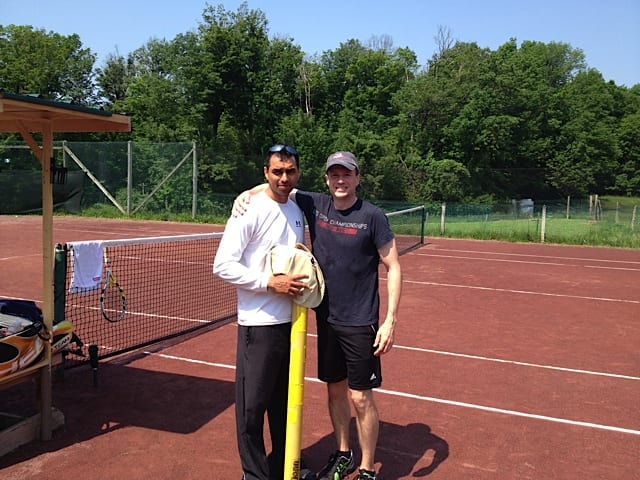The Art and Science of Fitness Training for Tennis (Or “How I Survived 9 Days of Tennis Camp”)
When I started playing tennis seriously 4 years ago, the last thing I was concerned about was my “fitness.” I had been in the habit of working out frequently since my 20s and even spent a few years working as a certified fitness trainer. So I figured I just needed to keep doing what I was doing in the gym while getting onto the court as much as possible to work on my actual tennis skills.
I couldn’t have been more wrong. My old workout routines proved totally inadequate in preparing my body for the relentless pounding, repetitive motion, and extreme movements we tennis players endure.
Think of the physical qualities serious tennis players need to excel on the court and prevent injury (this collage of photos I took at the US Open is a visual reminder):
- Lower body strength and explosiveness— with just about every muscle from toe to hip deployed
- Upper body strength — with the muscles of the back, chest, shoulder, upper arm, forearm and wrist all playing important roles
- Speed and agility — with the ability to stop on a dime and change direction moving forward, backward, and side-to-side
- Core and rotational strength – with the back and abdominal muscles being taxed constantly
- Endurance (especially “anaerobic”) — with ability to perform bursts of high-intensity movement repeatedly
- Flexibility (lower and upper body) — with the capacity to handle being thrown in all kinds of directions at high speeds and beyond usual range of motion
I learned how ill-prepared I was the hard way a few months after starting to play in fall 2008. I decided to check out for the first time a highly intensive tennis camp in upstate New York, Total Tennis. It was one of the best weekends of my life: a dream come true to just wake up and hit the courts for hours, get some great food, go back for more, then hang out in the evenings with other tennis addicts. I had such an incredible time and had made such encouraging progress that I signed up to return to camp the following weekend, and also made plans to play a few times in NYC the week in between. To get through it all, I popped a lot of Aleve to shut down the telltale signals from my body to slow down.
I came back from that second weekend with four overuse injuries: achilles tendonitis, a hamstring strain, an inflamed rotator cuff, and yes, the dreaded tennis elbow. It took about two frustrating months of time off the court and physical therapy to get healthy again. During that time, I resolved to “do more yoga” (for desperately needed flexibility) and to add a few sports-specific exercises to strengthen typically vulnerable spots for tennis players (rotator cuff, knees, etc). But even that wasn’t enough. I ended up getting hit with several more typical tennis overuse injuries the following year, including a serious calf strain, knee tendonitis, and a quadricep pull among others. You name it, I’ve probably dealt with it.
Thankfully today it’s an entirely different story, thanks to a total overhaul of my workouts. I’ve been injury free for almost a year, I’m faster and more explosive than ever on the court, and I recently even made it through nine consecutive days of 3-5 hours/day at Total Tennis unscathed. (My only physical setback recently was a groin strain due to getting thrown off a horse about a month ago –more on that at the bottom of this post— but I’m recovering fast!).
 The biggest credit for the turnaround goes to the amazing personal trainer I’ve been working with for about a year, Jay Gallegos. Jay approaches our tennis-specific workouts as both a science and an art. On the “science” side, he reads avidly, attends workshops regularly to keep up with new training techniques, and watches hours of video of elite tennis players in action. Among other things, Jay is trained in Corrective Exercise Training through the National Academy of Sports Medicine, which focuses on athlete rehabilitation and injury prevention. On the “art” side, Jay draws creatively on his vast knowledge both as a trainer and practitioner of functional movement (he’s excelled himself at weight lifting and martial arts, kickboxing, handball, and even Hip-Hop). The result is constant innovation and progression in our workouts.
The biggest credit for the turnaround goes to the amazing personal trainer I’ve been working with for about a year, Jay Gallegos. Jay approaches our tennis-specific workouts as both a science and an art. On the “science” side, he reads avidly, attends workshops regularly to keep up with new training techniques, and watches hours of video of elite tennis players in action. Among other things, Jay is trained in Corrective Exercise Training through the National Academy of Sports Medicine, which focuses on athlete rehabilitation and injury prevention. On the “art” side, Jay draws creatively on his vast knowledge both as a trainer and practitioner of functional movement (he’s excelled himself at weight lifting and martial arts, kickboxing, handball, and even Hip-Hop). The result is constant innovation and progression in our workouts.
Here are some of the keys to Jay’s approach to our workouts:
- “Training for function, not fashion.” This is Jay’s mantra, and I buy it. Instead of 5 sets of bench presses to make my pecs bigger, we do movements that engage all the muscle groups and tiny stabilizers required on court. While my chest and biceps may be a little smaller than they were a couple years ago, my on-court performance only continues to improve and I feel more impervious to injury than ever. Overall, I feel in better shape than I have in many years, and I know our workouts are also smarter for keeping my body strong and durable for the long-term.
- Increasing body awareness. For Jay, this is a #1 priority — and for me this focus in workouts has probably been my #1 game-changer on the court. It wasn’t long ago that I was throwing my body spastically every which way to chase down a tough ball. I also tended to play too “tight” and try to “muscle the ball.” Since working with Jay, I’ve been moving more fluidly and playing more “loose.” This has not only been great for injury prevention: it’s also helping me respond faster when coaches as me to make adjustments while unlocking a lot more power in my serve and shots.
- Integrating flexibility training into every workout. Flexible upper and lower-body muscles are vital in tennis– both to enable the body to respond rapidly to changes in movement and reach for tough shots (think return of serve) and also to enable maximum power (think service motion). As Jay says, “you can’t get a good crack out of a stiff whip.” My workouts no longer separate “lifting” from “stretching.” Instead, Jay integrates flexibility into most of the strength movements we do. Jay believes the training floor is where you “plan for the worst-case scenario”–so we often take movements just a little past the point of extension that would probably be needed on the court. No, I still can’t drop into a near split like Novak Djokovic, but my extension is steadily improving and I’m less worried than ever about hamstring or other strains.
- Finding control amidst instability. Tennis requires extraordinary balance and muscular control– including the ability to decelerate after ballistic movements. The sport also engages (and puts tremendous stress on) tiny stabilizing muscles, tendons and ligaments all over the body that can be easily neglected in workouts, especially around joints– wrists, shoulders, knees, ankles. To help my body find balance and control in challenging situations, Jay introduces instability into many movements in all kinds of crazy ways (Bosu balls, Step360s, 1-legged variations, etc). This also helps strengthen a lot of those little stabilizers that are so vital to protecting myself from injury.
- Variation. Jay’s workouts always keep my body guessing, which has made things both fun and really effective. No workout is ever the same, although all workouts use a progressive approach that builds in intensity and complexity of movement. Some workouts focus more on anaerobic endurance and feature many explosive movements and agility drills. Others focus primarily on core and rotational strength, while some emphasize upper body strength and flexibility. It all depends on what else we’ve been working on, how I’m feeling, and whether I have any matches or intense on-court sessions coming up.
A few of you have written to ask about my on- and off-court training regimen. The specifics fluctuate almost weekly for many reasons (my demanding job, the availability of courts and coaches, how my body is feeling)… but generally speaking here’s what I do:
- I practice tennis 4x/week 1-2 hours per session (usually 1 private lesson + 1 clinic or coached practice with teammates + 1 match or practice with a hired “hitter” (a 5.0+ player) + and 1 session alone to practice serve and strokes with the ball machine). I also go up to train 4-5 hours/day one weekend every 4-6 weeks at Total Tennis. I also warm-up for 5 minutes religiously before stepping onto the court (see bottom of this page for sample exercises) and do 10 minutes of static stretching after getting off the court.
- I do tennis conditioning workouts 2x/week (about one hour each) with Jay or on my own, followed immediately by 15 minutes of static stretching.
- I try to add a group training class 1x/week (alternating between yoga or sports conditioning classes) in addition to the above – but sometimes I either can’t squeeze that in or my body tells me to skip it
- I usually give my body 1 full day of rest per week, and try to get a sports massage every 2-3 weeks (if I could afford it I’d do it every week!)
I’ve set up an entire page on this blog, “Tennis Workouts & Fitness Training“ outlining many of the exercises I do in workouts with links to videos. I’ll keep updating the page and adding new videos every week. I’m still trying to figure out how best to set up the page to be most helpful to others, so if you have suggestions please let me know. The page does NOT prescribe any one workout routine, because everyone needs to tailor their routines to their individual needs and bodies. My goal for the page is to share some of the exercises that are working best for me– which hopefully will help you to design/refine a routine that’s best for you. My top recommendation is to enlist a high-quality personal trainer, even if for just 2-3 sessions, to help develop your plan.
Below are just a few of some of my favorite exercises Jay and I have done recently. I will start adding new videos regularly beginning this week. To receive updates when I post new videos, just subscribe to my YouTube channel.
* About the Photos: The first is of me working out with Jay doing a skating-like jump drill using Bosu balls. The collage includes only photos I took myself at the 2011 and 2012 US Open.
Feel Free to reach out to me directly at roadto45@gmail.com and be sure to follow me on social media!





[…] I outline in a post on “The Art and Science of Fitness Training for Tennis,” I vary my workouts constantly, depending on specific goals throughout the year and timing of […]
Told my wife, an avid runner, find me a regimen to make me the best tennis player possible. Here I am…Thanks PJ & Jay!
Hey Jim, that’s so cool – glad this may be able to help. I’m going to try to carve out some time to outline key lessons learned over the past year getting certified through iTPA, esp to help people think about frequency, sequencing, prioritizing certain types of exercises depending on their circumstances. Hopefully I can get a post done by fall that is even more helpful to you. Stay in touch and keep me posted on how you’re doing! PJ
Hey PJ,
Great blog. We met at Total Tennis last summer and finally got around to checking out your site. I’ll be referring to it as I prepare for the summer season. Keep it up!
-Derek
Derek, great to hear from you! Really appreciate the kind words. Look forward to seeing you back at TT one of these days soon I hope! P.J.
What a wonderful article PJ. You truly have captured the essence of our training. All I have to say is that everyone needs to experience our elite training. Seeing oneself perform at such a high caliber can be mind blowing and provide a supreme sense motivation to keep you succeeding on a lifelong journey.
Jay, the best in NYC